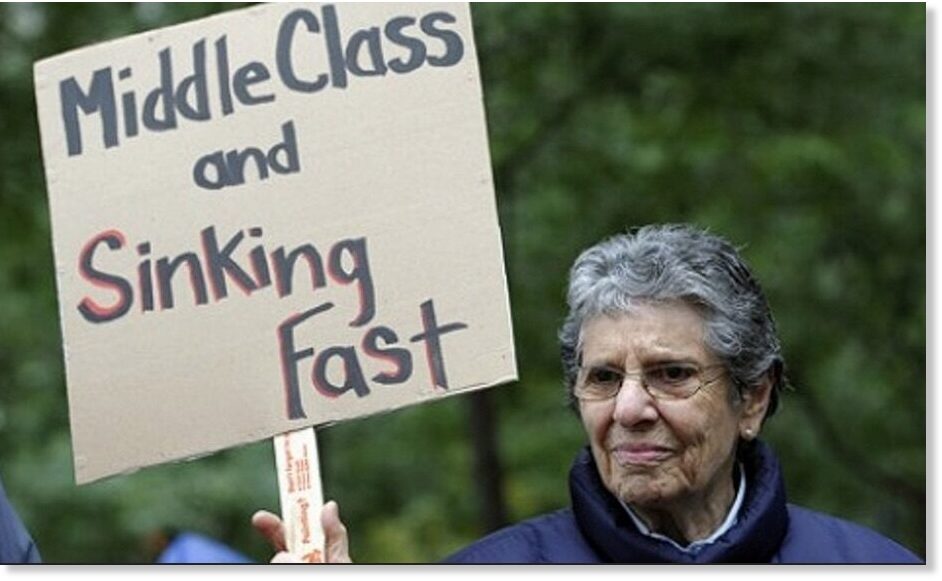It used to be that a high school education was enough to guarantee you a comfortable living, usually in some blue collar job, a high school diploma nowadays would barely get you beyond an entry level position somewhere. Even a four year college degree is no assurance of middle class lifestyle.
Of course, most of the good paying blue collar jobs have been exported overseas where corporations can exploit the need for jobs at any price while avoiding those pesky unions and OSHA requirements. Where for every opening there are literally thousands waiting in line to be hired.
It doesn't help that the quality of public schools have significantly declined over the decades to the point where many graduates have the academic equivalent of an eighth grade education. America was ranked 11th of 79 countries in science. While we ranked 30th in math, the top five ranked countries in math were all Asian. But, we're still tops when it comes to basketball!
A typical college graduate with four year bachelor degree hit the street looking for a job with an average debt of over 30,000. For a professional degree, like from medical or law school, the average debt is around $250,000 and $160,000 respectively. It takes the average college graduate 21 years to pay off their college loan debt.
The downside is that a substantial minority chose majors with little or no job demand, leaving them stuck with a huge financial burden and no way to pay it off. These and other graduates are now wanting taxpayers to pick up the tab under the misleading term of "forgiving" or "canceling" their academic debt. Why? We didn't pick their major. We didn't sign their loan papers or accept responsibility for their debt. That's their responsibility. It's called being an adult.But it doesn't end there. With all the additional expenses of simply "living" amid rising prices and stagnate wages, the average American household debt is $101,915 as of the end of 2022. The total national household debt is $17 trillion dollars as of the end of the first quarter of 2023. That effectively makes the majority of Americans literally indentured serfs. They are literally working to pay off a debt owed to someone else, which is almost always a corporation.
As an aside, 60% of Americans are living from paycheck to paycheck, including 49% of those with an income of over $100,000 along with 70% of millennials, and it looks like Gen Z is trending the same way. 30% of Americans have enough money in savings to cover an emergency for no more than 30 days. 22% have no financial safety net which includes 27% of those 59 and older.
Once they find a job, it's worth noting that wage inequality between genders remains a problem. Women are still earning, on average, just 82% of every dollar their male counterpart earns, which makes me curious about those who "identify" as transgender in the workplace. I wonder if they're going to be satisfied with their reality of their smaller paychecks?
Meanwhile, those at the top of the corporate ladder seem to be doing just fine. The CEO-to-worker compensation ratio was 399-to-1 as of 2021. That means that for every dollar a average employee earns, a top executive will get $399. From 2010 through 2021, wages grew by 31%, which sounds pretty good. However, thanks to the rate of inflation, wages have lost on average 4.5% of their purchasing power.
As if that's not bad enough, the top richest 1% own twice as much as the bottom 99% of the entire world's population! To put it another way, they've acquired over half of all the new wealth created over the last decade while the poorest half own just 0.75% of the wealth.In the United States, the top 1% own over one third of the nation's total wealth. Did I hear someone say "let them eat McDonalds"? Meanwhile the bottom 90% control just 30.2% of the wealth. In 2021, the top one percent's wealth grew by $6.5 trillion dollars...just in that one year! Their total stock portfolios were worth $23 trillion dollars.
As wealth increasingly becomes concentrated in the hands of fewer and fewer individuals and their corporations, so too does their political power. There have already been several academic studies showing America's shift to a government of, by, and for the oligarchy (or kleptocracy if you prefer). Wall Street's mega corporations now so controls Washington that we've become a defacto neo-fascist corporatocracy.
It shouldn't need pointing out, but we've also become a surveillance state thanks to the knee jerk reaction of Congress following 9/11 and its failure to read or comprehend the "Patriot Act" in 2001. We need wonder no more how or why the Germans succumbed to Hitler and the Nazis following the passage of the "Enabling Act" by members of the Reichstag on the heels of Reichstag fire in 1933.
Thanks to the Supreme Court's 2010 "Citizens United" blunder, Big Money literally owns the Democratic and Republican parties. They not only underwrite the two parties and their political candidates, they've pushed the cost of running for office almost entirely out of reach of the average citizen, thus making politics the virtual domain of the very rich.
Congress isn't about "the business of the people" as Speaker Nancy Pelosi so caustically said following the January 6th protest, as corporate lobbyists now routinely write or help draft legislation and advise legislators on how to vote on which bills.Consider this too. Millionaires, who make up just three percent of the total U.S. population, overwhelmingly control all three branches of government, including the Presidency, regardless of party affiliation. Middle and working class office holders have never dominated any branch of the federal government and are increasingly becoming rare at the state level.
Members of the Supreme Court together are worth an estimated $24 million dollars, and at least six of the nine Justices are multimillionaires. Even most federal judge positions are occupied by individuals who are at least in the top 5% financially. Of course, these positions come with their wealthy and powerful connections, making it even more difficult for the ordinary American to get a fair shake.
So, regardless of whether you vote Democrat or Republican, the wealthy win. It's just a matter of whether it's the blue corporate clique and their agenda or the red corporate clique and their agenda.
So, where does all this leave us? Historically, it's been the middle class which has held democracies together. The Founders envisioned the United States as a nation of yeomen farmers and small businessmen. Ideally, a democratic society should be shaped like two inverted diamonds---narrow at the top and bottom and wide in the center with a relatively few at the top and bottom with the majority of individuals located somewhere in the middle.
Of course, that's not what we have today. The United States used to be a majority middle class country. In 1971, over 61% of the nation was middle class. Today, just under half are. The lower middle class comprise approximately 25% of the population with another 25% making up the working poor and perpetual unemployed. In 2022 just 11.3% of workers were unionized. In 1960 it was almost one third of the country--31.9%. By 1975 it was 26.3% as technology replaced some workers and employers began sending other jobs overseas.America also used to be the place where someone could start from scratch, start a business, and through hard work make their way up into the middle class. It was part of the "American Dream". It's what many newly arrived immigrants hoped for. According to the U.S. Bureau of Labor Statistics, the "American Dream" may now be just that---a dream.
20% of all new businesses fail within their first two years of operation. 45% within their first five years, and 65% within ten years. Just 25% survive beyond that. The main reasons? A lack of cash flow, poor management, a lack of organization, and inadequate marketing.
When a society's economic system becomes unbalanced and where wealth and power are concentrated in the hands of small minority, social unrest is almost always the result, be it revolutions, civil wars, coups, or whatever. This is especially true when approval levels drop below 55% for any length of time, again, such as in the United States.
Currently, Congress has an approval rating of just 20%, or to put it another way, a disapproval rating of 76% with 4% having no opinion. In fact, the last time Congress had a positive approval rating over 50% was 2001---22 years ago!
As an aside, 77% of those surveyed said that the current members of Congress should not be reelected again, and yet thanks to corporate funding and partisan gerrymandering, some 95% of them will be reelected. The Supreme Court has an approval rating of roughly 40% and 66% of Americans have little or no confidence in the mainstream media to provide fair, honest and balanced news.This is what a broken political and economic system looks like, especially if you're one of few Americans clinging on to their middle class status. Rising prices, stagnant wages, the widest income disparity of any industrialized nation, poor healthcare (we're ranked 21st in the world with the highest infant mortality rating of any developed nation), a underperforming educational system.
At 76, our life expectancy is among the worse of any industrialized nation, coming in 40th in the world. In Japan it's 84. We have the world's highest national debt rate at $31.4 trillion. To put it another way, our national debt exceeds the next four countries---China, Japan, France, and Italy---combined, which as most economist will agree, is unsustainable, and yet we spend more on the military than the next ten nations combined.
Is there anything the American middle class can do? Maybe. Although the United States is in decline, perhaps terminally, we can still alter the existing political system to make it more responsive to the needs of its citizens and get corporate money and control out of politics.
We can bring jobs sent overseas back home or penalize those who don't. Let's make it more expensive to ship jobs overseas than to build it here. We can raise the tax rates on the wealthiest individuals and impose a minimum tax on big businesses. No more mega corporations earning more than some countries paying zero federal taxes or billionaires paying less taxes than fast food store manager.We can increase our investment in R&D projects and cut the red tape on new businesses, especially in the area of technology. We can---and must---improve our education and healthcare. We need to reduce our military budget to free up more money for social services and infrastructure. We need to put focus on all Americans, not just an elite few, and that means rebuilding the middle class once again.
If you
enjoyed the article, please consider passing it along to others and don't
forget to subscribe. It's free! Lastly please be sure to
"like" us on whatever platform you use to read anotheropinionblog.com. It helps with
the algorithms and keeps our articles in circulation. Thank you!
Average American Household Debt in 2023: Facts and Figures
U.S. Education Rankings Are Falling Behind the Rest of theWorld
Two Working Parent Households 2023: A Look at the Statistics
How the American Middle Class Has Changed in the Past FiveDecades
At Least 6 Supreme Court Justices Are Multimillionaires,Report Reveils
These 19 Fortune 100 Companies Paid Next To Nothing---orNothing At All---in Taxes in 2021







No comments:
Post a Comment